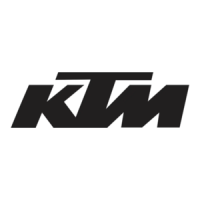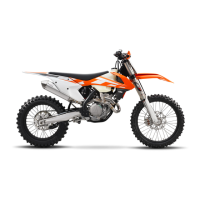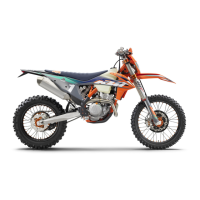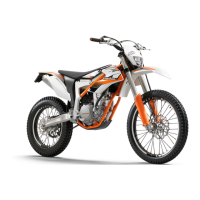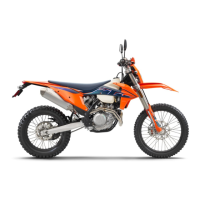Do you have a question about the KTM 350 XCF-W and is the answer not in the manual?
Defines vehicle's intended use, misuse dangers, and general safety precautions.
Explains danger symbols, tampering warnings, and safe operation guidelines.
Details required protective clothing, work rules, and environmental considerations.
Covers manufacturer warranty, fuel handling, and auxiliary substances.
Information on service importance, spare parts, and customer support.
Identifies key components from front left and rear right perspectives.
Locates VIN, type labels, key number, engine number, and part numbers.
Explains clutch, hand brake, throttle, kill switch functions.
Details horn, light switch, and turn signal switch operations.
Explains start button, emergency OFF switch, and indicator lamps.
Instructions for fuel tank cap operation and steering lock.
Overview of the instrument display, activation, and setting units/clock.
Explains display modes, lap times, odometer, trip masters, and average speed.
Essential advice for initial use, engine break-in, and low-temperature battery performance.
Preparing for difficult riding, dry sand, wet sand, and muddy conditions.
Critical pre-ride checks, starting the vehicle, and using traction control.
Guidance on shifting, braking techniques, and proper stopping/parking.
Guidelines for transporting the motorcycle and safe refueling practices.
Details periodic maintenance tasks required at different intervals.
Lists recommended service tasks and their intervals.
Adjusting chassis settings based on rider weight for optimal handling.
How to adjust shock absorber damping and spring preload.
Checking fork setting, adjusting compression and rebound damping.
Adjusting fork spring preload and handlebar position.
Procedures for using lift stand, bleeding fork legs, and cleaning dust boots.
Removing/installing triple clamps and adjusting steering head bearing play.
Removing/installing fender, seat, air filter box, and silencer.
Checking free travel and adjusting hand brake lever position.
Inspecting brake discs and changing brake linings for front and rear.
Checking and adding front and rear brake fluid.
Procedures for removing and installing front and rear wheels.
Inspecting tires for wear, damage, and checking tire pressure.
Removing, installing, and charging the 12-V battery.
Changing fuses, headlight bulb, and setting headlight range.
Checking antifreeze and coolant levels, draining and refilling coolant.
Checking and adjusting throttle cable play and routing.
Adjusting throttle response characteristic maps and engine mapping.
Adjusting idle speed and teaching throttle valve position.
Changing fuel screen and checking/adding engine oil.
Procedures for changing engine oil, oil filter, and oil screen.
Details engine design, capacities, chassis dimensions, and tightening torques.
Specifications for electrical components and tire sizes.
Technical data and adjustment ranges for fork and shock absorber.
Explanation of yellow and orange symbols indicating errors or driving aids.
Explanation of green and blue symbols providing informational feedback.
Defines vehicle's intended use, misuse dangers, and general safety precautions.
Explains danger symbols, tampering warnings, and safe operation guidelines.
Details required protective clothing, work rules, and environmental considerations.
Covers manufacturer warranty, fuel handling, and auxiliary substances.
Information on service importance, spare parts, and customer support.
Identifies key components from front left and rear right perspectives.
Locates VIN, type labels, key number, engine number, and part numbers.
Explains clutch, hand brake, throttle, kill switch functions.
Details horn, light switch, and turn signal switch operations.
Explains start button, emergency OFF switch, and indicator lamps.
Instructions for fuel tank cap operation and steering lock.
Overview of the instrument display, activation, and setting units/clock.
Explains display modes, lap times, odometer, trip masters, and average speed.
Essential advice for initial use, engine break-in, and low-temperature battery performance.
Preparing for difficult riding, dry sand, wet sand, and muddy conditions.
Critical pre-ride checks, starting the vehicle, and using traction control.
Guidance on shifting, braking techniques, and proper stopping/parking.
Guidelines for transporting the motorcycle and safe refueling practices.
Details periodic maintenance tasks required at different intervals.
Lists recommended service tasks and their intervals.
Adjusting chassis settings based on rider weight for optimal handling.
How to adjust shock absorber damping and spring preload.
Checking fork setting, adjusting compression and rebound damping.
Adjusting fork spring preload and handlebar position.
Procedures for using lift stand, bleeding fork legs, and cleaning dust boots.
Removing/installing triple clamps and adjusting steering head bearing play.
Removing/installing fender, seat, air filter box, and silencer.
Checking free travel and adjusting hand brake lever position.
Inspecting brake discs and changing brake linings for front and rear.
Checking and adding front and rear brake fluid.
Procedures for removing and installing front and rear wheels.
Inspecting tires for wear, damage, and checking tire pressure.
Removing, installing, and charging the 12-V battery.
Changing fuses, headlight bulb, and setting headlight range.
Checking antifreeze and coolant levels, draining and refilling coolant.
Checking and adjusting throttle cable play and routing.
Adjusting throttle response characteristic maps and engine mapping.
Adjusting idle speed and teaching throttle valve position.
Changing fuel screen and checking/adding engine oil.
Procedures for changing engine oil, oil filter, and oil screen.
Details engine design, capacities, chassis dimensions, and tightening torques.
Specifications for electrical components and tire sizes.
Technical data and adjustment ranges for fork and shock absorber.
Explanation of yellow and orange symbols indicating errors or driving aids.
Explanation of green and blue symbols providing informational feedback.
| Displacement | 349.7 cc |
|---|---|
| Bore x Stroke | 88 mm x 57.5 mm |
| Starter | Electric starter |
| Transmission | 6-speed |
| Cooling | Liquid cooled |
| Rear Suspension | WP XPLOR PDS shock absorber |
| Front Brake | Disc Brake |
| Rear Brake | Disc Brake |
| Ground Clearance | 370 mm |
| Seat Height | 960 mm |
| Weight (without fuel) | 106 kg |
| Engine Type | Single Cylinder, 4-Stroke |
| Fuel System | Electronic fuel injection (EFI) |
| Fuel Tank Capacity | 8.5 liters |
| ABS | Not equipped |
| Front Suspension | WP XPLOR-USD, Ø 48 mm |
